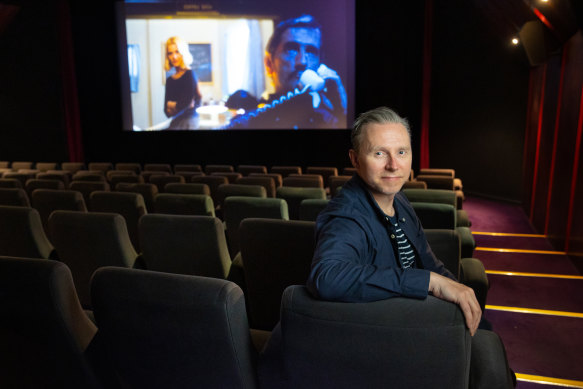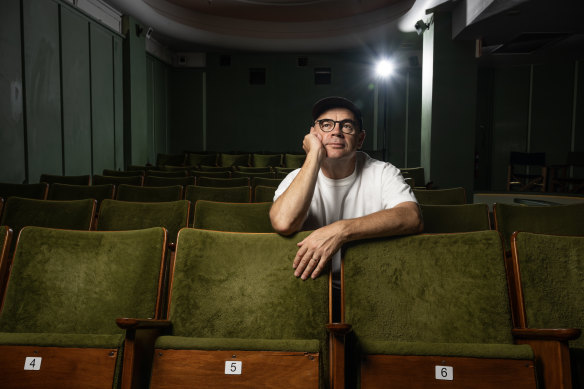Kristian Connelly fondly recalls the spine-tingling moment during childhood movie visits when the lights faded, the screen expanded, and the audience settled in for the trailers.
“I think it was the original Twister with Bill Paxton and Helen Hunt, and they played the teaser for The Lost World: Jurassic Park,” Connelly, chief executive of Cinema Nova in Melbourne’s Carlton, said.
“I would almost be happy to have just paid admission to see that. It was just so exciting to see a first glimpse.”

Kristian Connelly is the chief executive of Cinema Nova in Carlton. Credit: Simon Schluter
While trailers are beloved by many, it’s another fixture of the pre-show, the ads, that might be under threat. Director Todd Phillips, whose Joker: Folie à Deux failed to set the box office alight, this week told Empire that theatres should stop showing pre-show ads altogether.
“We’ve paid for our tickets. We’re excited to be there,” he said. “The commercials tend to take the air out of the room.”
Connelly, who regularly visits the US, said he too had noticed a shift there to extensive ads, though some independent cinema chains had eliminated them. With that in mind, Cinema Nova has reduced ads by a third, to around four minutes, with the rest of the 10-minute pre-show devoted to trailers.
Ads have always been part of the Australian cinema experience. Val Morgan, which provides advertising for almost all the country’s more than 2,200 screens, started advertising at live theatres in 1894, a year before the Lumière brothers opened the world’s first cinema in Paris.
But on-screen advertising now represents a fraction of cinemas’ income. The latest quarterly earnings report from AMC Theatres, the world’s largest operator, with 900 theatres covering 10,000 screens, said screen advertising contributed 2.3 per cent of total revenue, while admissions generated 55.2 per cent and food and beverage 36.4 per cent. The company made a $31.5 million loss between July and September.
Damian Keogh, chief executive of Hoyts Group, which includes Val Morgan, estimated ad revenue was around 5 per cent in Australia, but said with shrinking margins from smaller post-pandemic audiences, it could be the difference between profitability or not.
“I don’t think [removing ads] is going to bring more people to the cinema,” he said. “If anything, if we stopped advertising we’d have to put the ticket cost up, or we’d have to negotiate with the studios to give us a bigger share... which means less share to them … [and] to moviemakers like Todd Phillips.”

Damian Keogh, CEO of Hoyts Group, which includes screen advertising giant Val Morgan, said removing pre-show ads would not bring in bigger audiences.
Phillips’ comments have rankled at a time when theatres were counting on the second Joker instalment. The first film grossed $49 million in Australia in 2019, while Folie à Deux only made around $5 million in its opening week. Benjamin Zeccola, chief executive of Palace Cinemas, said Phillips’ suggestion was “a little bit rich” and not viable for smaller chains.
“The film itself is often a loss-leader,” he said. “The business of cinema keeps its head above water thanks to bar sales and advertising.”
But other independent theatres say they have already successfully cut back. Michael Smith, owner of the Sun Theatre in Melbourne’s Yarraville, said the venue doesn’t show any ads.
“We made a decision that the things that annoyed us at the cinema we wouldn’t inflict on other people,” he said, adding it had meant a “couple of hundred thousand dollars” of lost revenue, but had brought in more devoted audiences.

Barrie Barton, CEO of Golden Age Cinema in Surry Hills, which operates out of an art deco screening room once purpose-built for Paramount Pictures.Credit: Louise Kennerley
Instead, its pre-show includes trailers and a newsreel, once common until the 1970s, including news about local businesses, also fulfilling one of pre-show advertising’s historic roles.
Matthew Dunn, operations manager at Cinema Advertising Australia, which offers businesses on-screen advertising at a hyper-local level, at an average cost of around $400 a month, says ads still perform this important community service.
“People walk into the store, and they’ll recognise the store owner from the cinema ads.” he said. “It’s just a great way to break the ice.”
Economies of scale mean ads remain a necessity for some. Barrie Barton, chief executive of Golden Age Cinema in Sydney’s Surry Hills said advertising remained a modest but vital revenue stream.
Barton is in discussions to take over a four-screen, 500-seat theatre in Sydney’s Oxford Street, and said if he can set up a viable business without advertising, he will eliminate it.
“I tend to time my arrival into the theatre itself with the conclusion of the ads and the start of the trailers,” he said.
Although Cinema Nova has advertising, it has introduced something Connelly says is its innovation, a board displaying the pre-show and film’s actual start times.
Paul Crosby, an economics lecturer at Macquarie, said given streaming services, including Netflix, Prime and Paramount, have ads, theatres could do well to differentiate customers’ experiences. But, he added, there was “not that much to suggest that people aren’t willing to tolerate adverts”.